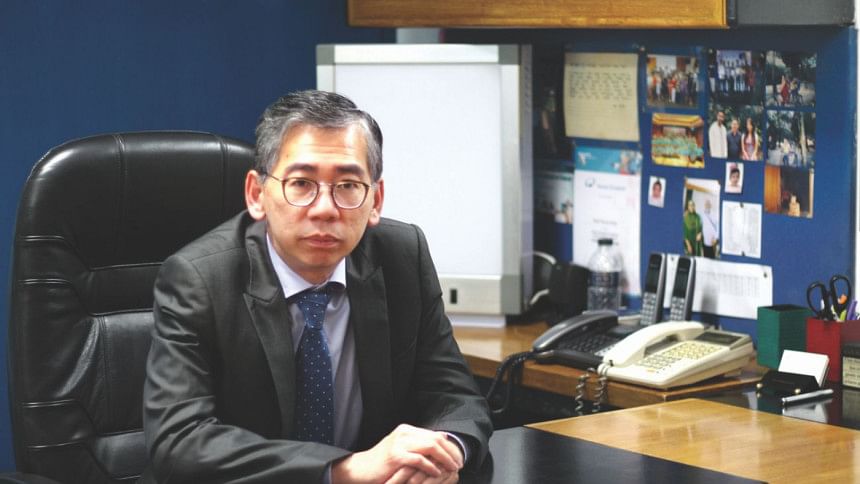Immunotherapy: in conversation with Dr Lim Hong Liang

Parkway Hospitals is without a doubt one of the top private healthcare providers in Asia. Based in Singapore, they have an office dedicated to their cancer centre which is situated in Gulshan 2. With over 25 years experience in medical oncology behind him, Dr Lim Hong Liang is just one member of the prominent team of doctors working for the hospital.
Specialising in lung cancers, Dr Lim spoke to Lifestyle about the disease and the various treatments available to people suffering from it, as well as medical breakthroughs that suggest that a cure for cancer may not be too far off.
During his time at the University Hospital in Singapore, Dr Lim got the chance to undertake his residency at a local lung cancer clinic.
“Lung cancer is probably one of the commonest cancers and at that time we were starting to do specialisation. It is fortunate that there was also a scholarship attached to the lung cancer unit at the National Cancer Centre in Tokyo. It was a matter of training and opportunity,” Dr Lim says, “as well as a personal interest. It also depends on what the department needs.”
Although he is based in Singapore, Dr Lim travels to Dhaka annually and attended the Bangladesh Cancer Congress that took place in Dhaka last month.
“During the conference they said that lung cancer is the commonest cancer in males in the country. I think that worldwide it is in the top three cancers, but how common lung cancer is in each country depends on the prevalence of smoking. Where smoking prevalence is high, the rate of lung cancer is high, and vice versa.”
Smoking may be the obvious cause for lung cancer, but Dr Lim says that there are other risks that may not come to mind when thinking about other causes.
“The rest of the causes are minor,” he says, “but the most obvious one other than smoking is asbestos. The risk of lung cancer caused by asbestos is actually very high, but the chance of exposure to asbestos is decreasing, because people are aware of the dangers, and some countries have even banned the use of asbestos.
“The other big one is air pollution – it is there, but it isn't very high. For example, if you compare a non-smoker to a regular smoker, the risk of developing lung cancer is increased by 15 times. And similarly, if you compare a passive smoker to a non-smoker the risk is only 1.5 times, so it's not as high. That's also the same figure when it comes to environmental pollution, so it's not close to smoking but it is still there and it is still a risk factor.”
There's a wide variety of treatments available for patients with cancer, depending on what stage they are in and the type of cancer that they have.
“When caught early, Stage 1 and 2 lung cancers can be cured by surgery. For Stage 3, there is still a chance of cure, but here the primary treatment is radiation. Stage 4 is incurable, and uses drugs to treat symptoms. Traditionally for Stage 4 we use chemotherapy, and then the next group of treatments is targeted treatments.”
Using targeted treatments for lung cancers is fairly new, having been introduced only 12 years ago. It has been shown to be much more effective than chemotherapy, as the chance of control is higher, and the patient lives longer.”
Targeted treatment may seem like the breakthrough cure that we have all been waiting for but it is more complicated than it seems.
“About 10-15 years ago we reached a plateau with regards to what chemotherapy can do. We are now reaching a similar result with targeted treatment. We are looking for more and more targets, and more driver mutations. With each new driver mutation, we learn what makes the cancer cells change, so we can design and develop drugs against that mutation. For existing mutations we also have new and more effective drugs.
“For example” he says, “the first driver mutation, EGFR – epidermal growth factor receptor – was first described in 2004. What they found is that with this mutation, with drugs that targeted genetic change, there was a good response in patients. And if they developed a resistance, they were given new drugs – the latest batch of drugs for the 3rd generation was approved very recently, so we are always developing new drugs for existing mutations.”
For the last 2-3 years, Dr Lim says the main interest in cancer treatment has been immunotherapy, which uses the body's immune system to fight the cancer cells.
“We have been talking about immunotherapy for years – the concept is that the body's cells divide all the time and sometimes during cell division, something may go wrong. The cells become abnormal. These abnormal cells are recognised by our immune systems and get cleared off. But when the cancer cells develop, the immune system is unable to recognise them as foreign, or bad, so we develop immune tolerance.
“There were high hopes for vaccinations as cures for lung cancer but 2-3 years ago trials showed that they actually made no difference. People also took white blood cells from cancer patients and stimulated them in laboratories, and then reinserted them in the patients. That was also found to be unsuccessful.”
Over the last few years a new group of drugs has emerged, called checkpoint inhibitors, however, these do not stimulate the body's immune system. Instead, the drug targets checkpoints which are used by cancer cells to avoid detection by the immune system.
“During an infection, your immune system revs up and attacks the infection, but you cannot keep revving it up, so the body has a feedback mechanism to dampen its immune system. Checkpoint inhibitors break down this inhibition.”
Checkpoint inhibitors have been proven to be effective in patients with Stage 4 melanoma of the skin, and are now being used for a lot of tumours.
“It looks very promising. This group of immunotherapy drugs will be big for the next 5-10 years,” Dr Lim suggests, “the same way targeted treatment has been big for the last decade.”
Learning how to manipulate the immune system in more and more ways is a significant breakthrough in finding a cure for cancer.
“This is an important topic, and it's very hot – in fact, when you go to conferences in America, the only thing they talk about is immunotherapy.”
“This is definitely the major breakthrough,” Dr Lim says, “and it's not just for lung cancers, but for treating cancer in general. Although immunotherapy has been used loosely in the past for passive treatments, this is the first time it has been used in a big way.”
“First melanoma, and then lung – I'm sure it will be proven to be effective for other types of cancer in the future too.”
Medicine is evolving, and scientists are finding out more ways to treat diseases that were once deemed as totally incurable. Now, with medical advances, we are learning that there are options available for cancers in various stages. And one day, there may even be a cure for Stage 4 cancers, to eradicate it completely and ensure that patients go on to live long, healthy lives.
By Zahrah Haider
Photo: Zahrah Haider
With special thanks to Dr Lim Hong Liang, senior consultant, Parkway Cancer Centre.

 For all latest news, follow The Daily Star's Google News channel.
For all latest news, follow The Daily Star's Google News channel. 



Comments